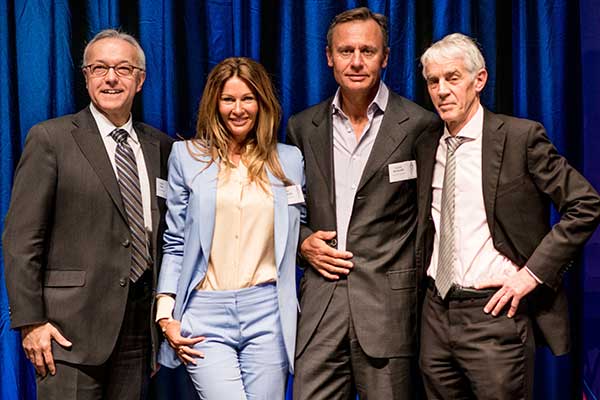
The mysteries of the human mind have tantalized scientists, philosophers, writers and artists for centuries. Now an international collaboration of neuroscientists is poised to unravel some of the most confounding mysteries of human cognition, memory and learning.
Harvard Medical School scientists, including HMS Dean George Q. Daley, and colleagues from the École Polytechnique Fédérale de Lausanne (EPFL) teamed up in Switzerland on April 7 at the 2017 Symposium of the Bertarelli Program in Translational Neuroscience and Neuroengineering. The event was held at Campus Biotech in Geneva, a new center of excellence in biotechnology and life science research that is part of the Swiss Innovation Park.
The annual symposium, a collaboration among the two schools and the Bertarelli Foundation, is an effort to spark transnational and translational partnerships among preeminent neuroscientists who are on a quest to propel knowledge from the lab to clinic.
Six of the 12 presenters were scientists from HMS. Other speakers participating in the symposium included scientists from EPFL, the Jules-Gonin Ophthalmic Hospital, New York University and the University of Pennsylvania.
Topics included mechanisms of visual perception, tissue engineering approaches to vision restoration, the molecular underpinnings of memory storage, gene therapy for hearing restoration, brain stimulation, and memory modulation, among others.
“Advances in the neuroscience of learning, memory and sensory perception are giving us new hope for treatment of some of the most devastating neurologic and psychiatric disorders,” said David Corey, a neurobiologist and the Bertarelli Professor of Translational Medical Science at HMS. “The cross-pollination that occurs from our international association with the Bertarelli Foundation and École Polytechnique Fédérale de Lausanne is just the sort of catalytic effort that can propel us toward delivering on that promise.”
“Advances in the neuroscience of learning, memory and sensory perception are giving us new hope for treatment of some of the most devastating neurologic and psychiatric disorders” — David Corey
“This symposium, at which our teams of scientists join together to share their work, is a demonstration of the mission of the Bertarelli Program as a whole: to foster collaboration across continents and across disciplines,” said Ernesto Bertarelli, co-president of the Bertarelli Foundation and a member of the HMS Board of Fellows.
“As with every symposium we hold, to hear in person the extraordinary progress being made across our joint projects is to be hugely encouraged. I—and everyone in the room at Campus Biotech—left with great hope for what is being achieved now and what will be achieved in the future,” he said.
Bertarelli is also this year’s recipient of the Albert Gallatin Award. Named for a Swiss immigrant to the colonial United States who served the new country in many ways, it is given by the Swiss-American Chamber of Commerce in recognition of exceptional contributions by individuals who foster a better understanding and appreciation between the peoples of Switzerland and the United States.
The Bertarelli Program in Translational Neuroscience and Neuroengineering was launched with a gift from the Bertarelli Foundation in 2010 to address some of the most important questions in medical neuroscience that, once solved, would have life-changing outcomes for patients across the globe. Its focus is not just on stimulating new cross-disciplinary research but also on establishing cross-border and cross-institutional working communities for knowledge sharing. The aim of these collaborations is to bridge the gap between basic and translational neuroscience by supporting basic and clinical research oriented toward translational opportunities, by creating stronger ties among scientists, engineers and clinicians, and by training the next generation of leaders in the field.


